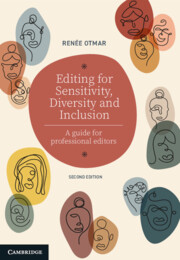Book contents
- Editing for Sensitivity, Diversity and Inclusion
- Acknowledgement of Country
- Editing for Sensitivity, Diversity and Inclusion
- Copyright page
- Dedication
- Contents
- About the author
- Preface
- Acknowledgements
- Part One Foundations
- Part Two Professional practice
- Chapter 5 Identifying the explanatory framework within a text
- Chapter 6 Literary worth versus literary intention
- Chapter 7 Plagiarism
- Chapter 8 Literary appropriation
- Chapter 9 Cultural appropriation
- Chapter 10 Decolonisation
- Chapter 11 Legal reading
- Chapter 12 The main types of critical appraisal
- Chapter 13 Editing for sensitivity, diversity and inclusion
- Chapter 14 Moral and ethical dimensions of editing
- Chapter 15 Developing a workplace policy and style guide
- Chapter 16 Principles for a professional practice
- Chapter 17 Care of the self
- Conclusion
- Part Three Guide
- Index
Chapter 13 - Editing for sensitivity, diversity and inclusion
from Part Two - Professional practice
Published online by Cambridge University Press: 24 August 2023
- Editing for Sensitivity, Diversity and Inclusion
- Acknowledgement of Country
- Editing for Sensitivity, Diversity and Inclusion
- Copyright page
- Dedication
- Contents
- About the author
- Preface
- Acknowledgements
- Part One Foundations
- Part Two Professional practice
- Chapter 5 Identifying the explanatory framework within a text
- Chapter 6 Literary worth versus literary intention
- Chapter 7 Plagiarism
- Chapter 8 Literary appropriation
- Chapter 9 Cultural appropriation
- Chapter 10 Decolonisation
- Chapter 11 Legal reading
- Chapter 12 The main types of critical appraisal
- Chapter 13 Editing for sensitivity, diversity and inclusion
- Chapter 14 Moral and ethical dimensions of editing
- Chapter 15 Developing a workplace policy and style guide
- Chapter 16 Principles for a professional practice
- Chapter 17 Care of the self
- Conclusion
- Part Three Guide
- Index
Summary
Writers have a responsibility to reflect the standards of the society in which they are creating their works and earning their living. They have the good fortune of being able to “speak” directly to their readers, and thereby to inform and educate them (however subtly that might occur), as well as to entertain and inspire.
The people they write about in non-fiction works and the characters they create in works of fiction represent real people in society in one way or another: good, bad, mediocre or indifferent, or a mixture of some or all of those qualities.
As humans we all deserve to be depicted as we are and as we choose to be identified: authentically and respectfully, and not as caricatures or stereotypes. The considerable body of published research and other literature illustrates just how harmful stereotypes can be. For example, negative racial stereotypes, including internalised racism, have been directly associated with actual harm to people’s economic/material, physical, intellectual, emotional and spiritual wellbeing.
Keywords
- Type
- Chapter
- Information
- Editing for Sensitivity, Diversity and InclusionA Guide for Professional Editors, pp. 124 - 134Publisher: Cambridge University PressPrint publication year: 2023



